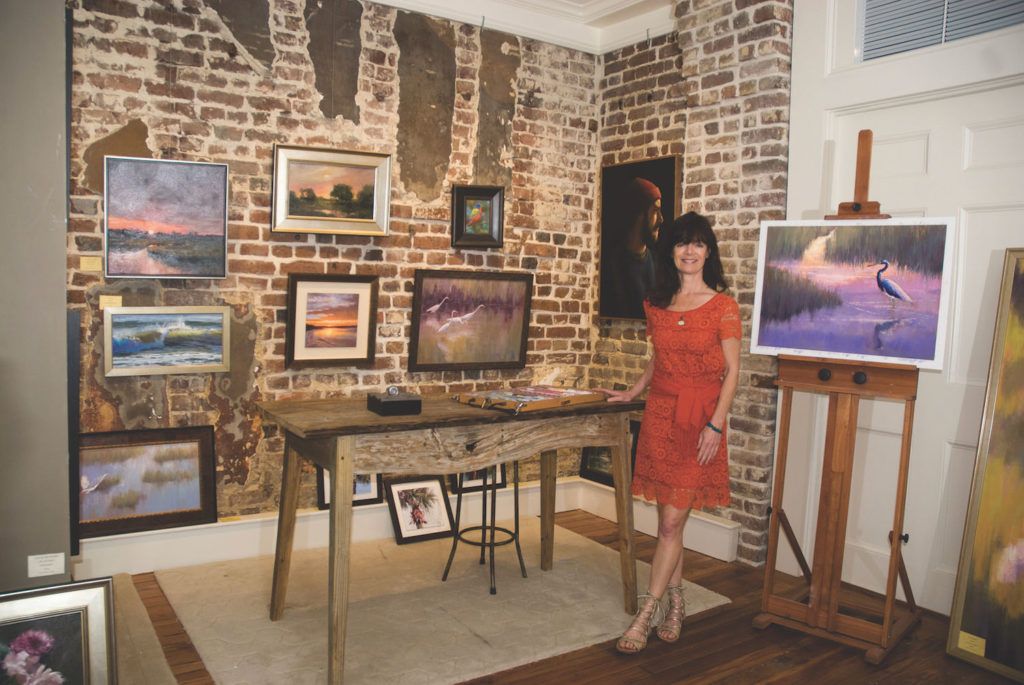how to get a gallery show
6 Art Gallery Essentials for Artists
Whether you've decided to take the first steps in getting your work shown in an art gallery or you're an established artist looking to expand your presence into new cities, understanding the fundamentals for how an art gallery selects its artists is essential.

As both a gallery owner and an artist in one of the most vibrant art cities in the U.S. — Charleston, South Carolina — Cecilia Murray knows a thing or two about getting art shown at galleries. Below, she breaks down critical steps artists should take before seeking out potential representation. Enjoy!
1. Offer a Unique Artistic Vision
One of the first things I look for in a prospective artist is a substantial and consistent body of work with a distinct point of view and direction. I'm looking for someone with a clearly developed style and approach, whether it's an intriguing choice of subject, composition, palette, surface texture or lighting. To set yourself apart from other artists, present a unique, exciting body of work that demands attention. How? Build and refine your artistic vision, and consider your current body of work. Focus on the subject matter that incites the most enthusiasm. The subjects that most excite you likely will inspire your best paintings, which will, in turn, best engage viewers. Focus your thoughts and immerse yourself in one genre. This will make building a cohesive, interesting body of work much easier.

2. Be Your Own Toughest Critic
Look at established artists' websites and social media accounts, like Instagram. Note how, even when viewed as a thumbnail, successful artists present a well-designed collection of work, with a wonderful sense of light and a beautiful palette. Now, look at your work as a collection. Do you have at least two-dozen paintings that hold together as a single body of work? If there's room in your home or studio, I suggest hanging several paintings on one wall, as if they were in an art gallery, in order to evaluate. Ask yourself what it is about your work that's unique. Are your landscapes more textured and bold, or perhaps more tonal in palette than others you've seen? Are your portraits painted from life, and overflowing with emotion and light? Is your work more subtle and moody than other still lifes you've seen? If you're unsure of the answers to questions like these, ask fellow artists for feedback, and challenge yourself to push a little further into your subject matter. Many artists and galleries offer portfolio critiques. These are good investments in gaining an impartial perspective on your work. Another effective way to assess your own work is to consider the answer to these questions: What's the message I want to send as an artist? If I had to describe my work in one sentence, what would it be? A wildlife artist represented in my gallery states, "I enjoy using color and texture to express the unique personality of each animal, whether it be a bit of sass or a touch of goofiness." This is an artist who has edited and refined her artistic vision. That statement is a reflection of the wonderful, colorful birds she paints. She has a strong, consistent message.

3. Highlight Your Best Work
In my seminar on approaching galleries, I highly recommend editing your collection down to its strongest works. In all likelihood, unless you're quite well established, an art gallery won't carry more than one genre of your work at the beginning of your partnership. For example, if you're most passionate about portraits and still lifes, don't include landscapes and wildlife — even if you paint them occasionally — in your presentation to a gallery. Only the paintings that best represent your vision and passion as an artist should be visible on your website. Similarly, if you enjoy painting seascapes but don't plan to present them to a gallery, take them off your website and social media platforms. Since growth as an artist is natural, should an earlier work no longer represent your current accomplishments, I recommend removing it. Paintings that are decades old may still be relevant to your current work, but if they're not, my motto is, "Promote the best, hide the rest."

4. Consider Location
Does your work have specific regional, national or international appeal? Cityscapes of iconic locations in New York, Paris and Florence will appeal to most clients, regardless of location. But if you paint local landscapes, your work is more likely to be successful when represented by galleries in your area. I recently worked with an artist who lives on the Northeast Coast. However, her most inspired, dramatic and impressive work stems from the time she has spent in the mountainous regions of New England. I proposed that she'd do well to return to the mountains to seek representation until she'd built up a larger portfolio of work inspired by the coast. Even if your work isn't location specific, you'll still need to research the region where you're seeking gallery representation. Natural light, local color and interior design vary greatly when you move across the country. Your success in a new region may be as simple as a slight shift in color palette. For instance, I admired the work of a Utah artist who was seeking representation in my gallery on the South Carolina coast. While her avian subjects would fit in nicely with my area's local fauna, her color palette was quite earthy. Though perfect for a mountain home, it was not appropriate for the majority of coastal homes in South Carolina. A small shift to a slightly lighter and bluer background could be her key to successful painting sales in my part of the country.

5. Let Your Artistic Vision Shine
As you create a body of work in preparation for representation, take note of these three points: Focus on your inspiration, edit your work to its strongest pieces and always keep in mind the message you want to send as an artist, both online and in person. If you create your own unique, exciting and iconic artwork, your message will shine through.

6. Get More Exposure
In addition to art gallery representation, a great way to garner more exposure as an artist is through art competitions. Entering art contests and competitions elevates an artist's visibility within the art world. And, winning a competition also can increase an artist's confidence in his or her work. Both of these points help artists prepare for open calls often held by art galleries. What's more, the prizes include cash, publication in worldwide art magazines or books, and access to judges who are influencers in the art world — and sometimes exhibitions of work. Ready to start entering art competitions? Check out this free guide on how to enter art contests. Then peruse the openart competitions held by Artists Network, including the Artists Magazine Annual Art Competition, which includes a Grand Prize retreat to Tuscany, Italy for rejuvenation, inspiration and art-making! Onward, artists! A version of this article, written by Cecilia Murray, was featured in Pastel Journal. Subscribe now to never miss out on the latest issue.
how to get a gallery show
Source: https://www.artistsnetwork.com/art-business/steps-art-gallery-representation/
Posted by: huntthiskes.blogspot.com

0 Response to "how to get a gallery show"
Post a Comment